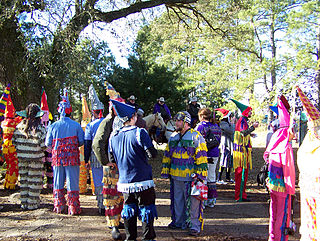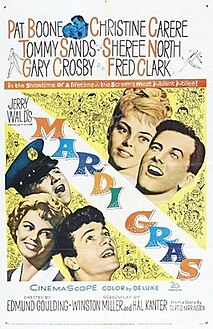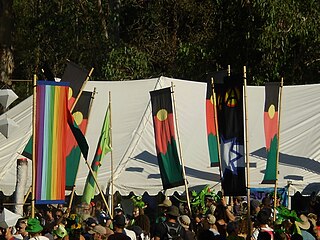 W
WMardi Gras, or Fat Tuesday, refers to events of the Carnival celebration, beginning on or after the Christian feasts of the Epiphany and culminating on the day before Ash Wednesday, which is known as Shrove Tuesday. Mardi Gras is French for "Fat Tuesday", reflecting the practice of the last night of eating rich, fatty foods before the ritual Lenten sacrifices and fasting of the Lenten season.
 W
WMardi Gras in the United States is not observed nationally across the country, largely due to the country's Protestant and Anglo roots. Mardi Gras and Carnival are mostly Catholic holidays, while the United States has a Protestant majority population. However, a number of cities and regions in the U.S. have notable Mardi Gras or Carnival celebrations. Most of these places trace their Mardi Gras celebrations to French, Spanish, and other Catholic colonial influences on the settlements over their history. The earliest Carnival celebration in North America occurred at a place on the west bank of the Mississippi river about 60 miles downriver from where New Orleans is today; this Mardi Gras on the 3 March 1699 and in honor of this holiday, Pierre Le Moyne, Sieur d'Iberville, a 38-year-old French Canadian, named the spot Point du Mardi Gras near Fort Jackson. The earliest organized Carnival celebrations occurred in Mobile, Biloxi, New Orleans, and Pensacola, which have each developed separate traditions. In addition, modern activities generally vary from city to city across the U.S.
 W
WThe Mardi Gras mystic society of Cain’s Merry Widows was founded in 1974 in Mobile, Alabama, home of the first Mardi Gras in America (1703). Each Mardi Gras, The ladies, known variously as "The Merry Widows of Joe Cain", "Joe Cain's Widows", or even just as "The Widows" gather on Joe Cain Day, clothed in black mourning clothes with veils, to lay a wreath at Cain’s burial site at Church Street Graveyard, wail over their "departed husband's" grave, then travel to Joe Cain’s former house on Augusta Street to offer a toast and eulogy to their "Beloved Joe".
 W
WA capuchon is a cone-shaped ceremonial hat worn during the Mardi Gras celebration in the Cajun areas of southern Louisiana, known as the Courir de Mardi Gras. The rural celebration is based on early begging rituals, similar to those still celebrated by mummers, wassailers and celebrants of Halloween. As Mardi Gras is the celebration of the final day before Lent, celebrants drink and eat heavily, but dress in costume, ostensibly to protect their identities.
 W
WThe Courir de Mardi Gras is a traditional Mardi Gras event held in many Cajun and Creole communities of French Louisiana on the Tuesday before Ash Wednesday. Courir de Mardi Gras is Louisiana French for "Fat Tuesday Run". This rural Mardi Gras celebration is based on early begging rituals, similar to those still celebrated by mummers, wassailers, and celebrants of Halloween. As Mardi Gras is the celebration of the final day before Lent, celebrants drink and eat heavily, dressing in specialized costumes, ostensibly to protect their identities. In Acadiana, popular practices include wearing masks and costumes, overturning social conventions, dancing, drinking alcohol, begging, trail riding, feasting, and whipping. Mardi Gras is one of the few occasions when people are allowed to publicly wear masks in Louisiana. Dance for a Chicken: The Cajun Mardi Gras, a documentary by filmmaker Pat Mire, provides great insight into the history and evolution of this cultural tradition. In popular culture, two HBO series also make reference to the tradition.
 W
WFastnacht Day is an annual Pennsylvania Dutch celebration that falls on Shrove Tuesday, the day before Ash Wednesday. The word translates to "Fasting Night" or “Almost Night” in English. The tradition is to eat the very best foods, which are part of the German tradition, and much of them, before the Lenten fast. Fastnachts are doughnuts. There are three types of Fasnacht, one made with yeast, one made with baking powder, and one made with potatoes and yeast. All are slightly crispy on the outside and not as sweet as standard doughnuts.
 W
WThe Sydney Gay & Lesbian Mardi Gras, Sydney Mardi Gras, or Mardi Gras festival in Sydney, Australia, is attended by hundreds of thousands of people from around Australia and overseas. One of the largest such festivals in the world, Mardi Gras is the largest Pride event in Oceania. It includes a variety of events such as the Sydney Mardi Gras Parade and Party, Bondi Beach Drag Races, Harbour Party, the academic discussion panel Queer Thinking, Mardi Gras Film Festival, as well as Fair Day, which attracts 70,000 people to Victoria Park, Sydney.
 W
WJoseph Stillwell Cain, Jr. is largely credited with initiating the modern way of observing Mardi Gras and its celebrations in Mobile, Alabama, following the Civil War. In 1868, while Mobile was still under Union occupation, Joe Cain paraded through the streets of Mobile, dressed in improvised costume as a fictional "Chickasaw" chief named Slacabamorinico. The choice was an attempt to insult to U.S. Army forces in that it was believed by some that the Chickasaw tribe had never been defeated in war. Joe was joined at some point by six other Confederate veterans, parading in a decorated coal wagon, playing drums and horns, and the group became the "L. C. Minstrel Band", now commonly referred to as the "Lost Cause Minstrels" of Mobile.
 W
WLaskiainen is a celebration with Finnish origins, which includes both pagan and ecclesiastic traditions, and is often described as a "mid-winter sliding festival".
 W
WThe Poklad (Carnival) event held yearly on the remote Adriatic Island of Lastovo is one of the more distinctive and authentic carnival traditions celebrated in all of Croatia today. All the island residents participate by wearing folk costumes. The origins of the Lastovo carnival go back to a historical event. Legend has it that Catalan pirates attacked neighbouring Korčula and sent a Turkish messenger to Lastovo to tell the islanders to surrender or they would be next. The inhabitants of Lastovo did not let themselves be intimidated – instead they armed themselves and went on the attack. The women and children walked to Hum barefoot from Lastovo and prayed to Sv. Jure for help and their prayers were answered: a storm destroyed the pirates' ships and the inhabitants of Lastovo caught the messenger. In order to mock him, he was taken through the village on the back of a donkey and was afterwards sentenced and burned to death. This event is celebrated through the Poklad every year over a period of two days just before Lent.
 W
WThe Magnolia Hotel was built in 1847 to serve as a lodging establishment. It is thought to be the oldest surviving hotel on the Mississippi Gulf Coast. The hotel was added to the National Register of Historic Places in 1973, and was designated a Mississippi Landmark in 1985.
 W
WMardi Gras is a 1958 American musical comedy film directed by Edmund Goulding and starring Pat Boone and Christine Carère.
 W
WMardi Paws is a Mardi Gras procession in Covington, Louisiana dedicated to animal welfare.
 W
WMardiGrass is a cannabis law reform rally and festival held annually in the town of Nimbin, in north east New South Wales, Australia.
 W
WMaslenitsa is an Eastern Slavic religious and folk holiday, which has retained a number of elements of Slavic mythology in its ritual, celebrated during the last week before Great Lent, that is, the eighth week before Eastern Orthodox Pascha.
 W
WA mystic society is a Mardi Gras social organization in Mobile, Alabama, that presents parades and/or balls for the enjoyment of its members, guests, and the public. The New Orleans Krewe is patterned after Mobile's Mystics. The societies have been based in class, economic and racial groups. Mobile's parading mystic societies build colorful Carnival floats and create costumes around each year's themes.
 W
WThe Order of Myths is a 2008 documentary film directed by Margaret Brown. It focuses on the Mardi Gras celebrations in Mobile, Alabama, the oldest in the United States. It reveals the separate mystic societies established and maintained by black and white groups, and acknowledges the complex racial history of a city with a slaveholding past. While showing the mystic societies' ties to economic, class and racial stratification, the film also showed the beginnings of interaction between the black and white courts. It also tells some of the history of Africatown, a community formed north of Mobile in 1860 by Africans from Ghana, transported illegally as slaves to Mobile decades after the end of the slave trade.
 W
WThe Paris Carnival is a carnival in the city of Paris in France. It occurs after the Feast of Fools and has been held since the sixteenth century or earlier, with a long 20th century interregnum.
 W
WThe Pink Loerie Mardi Gras and Arts Festival is an annual LGBTQ Pride carnival event and parade held in Knysna, a coastal township in the Western Cape province of South Africa. Events include their version of the Wigstock drag queen festival, a bear fest, athletic events, and an art festival. It is one of the country's largest LGBTQ events. Since its start in 2000 it has grown to be a significant event for the town culminating in the grand finale of Pink Loerie, Knysna Pride parade and its 1000-person after-party held on the final weekend with floats, performers, and DJs. The Knysna loerie is a green bird but the color pink has a long association with LGBTQ culture.
 W
WPowder Day or Day of the Powder is celebrated in the southern Spanish village of Tolox on Shrove Tuesday, the final day of the annual Tolox carnival. This local tradition involves the throwing of talcum powder at one another.
 W
WThe Quebec Winter Carnival, commonly known in both English and French as Carnaval, is a pre-Lenten festival held in Quebec City. After being held intermittently since 1894, the Carnaval de Québec has been celebrated annually since 1955. That year, Bonhomme Carnaval, the mascot of the festival, made his first appearance. Up to one million people attended the Carnaval de Québec in 2006 making it, at the time, the largest winter festival in the world. It is, however, the largest winter festival in the Western Hemisphere.
 W
WShrove Tuesday is the day before Ash Wednesday, observed in many Christian countries through participating in confession and absolution, the ritual burning of the previous year's Holy Week palms, finalizing one's Lenten sacrifice, as well as eating pancakes and other sweets.